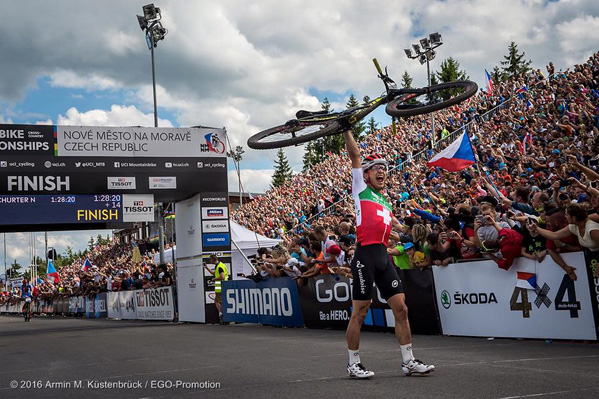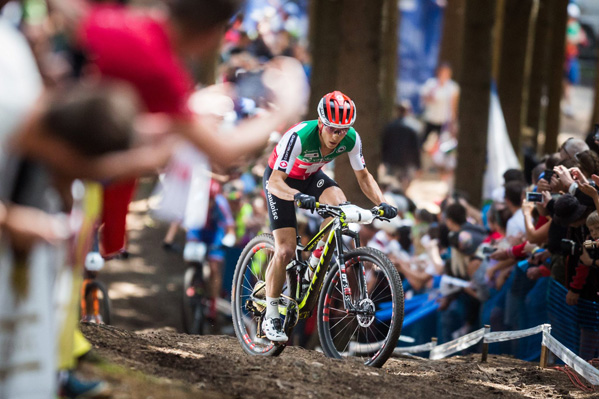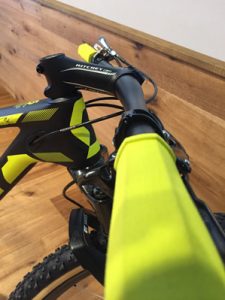Nino Schurter’s very recent switch to 29-inch wheels seems to be paying off. The 30-year-old Swiss ace won his fifth Elite Men’s XCO World Championship title at Nove Mesto, Czech Republic at the weekend. It was a composed performance that’s only possible when a rider is ‘at one’ with his bike. But why did he make the shift to 29-inch wheels when he’s been so successful on his beloved 27.5-inch (650b) hoops?
By Sean Badenhorst
Photos: Dino Lloyd/Martin Bissig/Michal Cerveny/Armin M.Kustenbruck
It was in Pietermaritzburg, South Africa at the opening round of the 2012 UCI World Cup where Schurter first raced to victory on his brand new 27.5-inch SCOTT Scale. It was a big deal because 29-inch wheels had been all the rage since their arrival on the World Cup circuit in 2010. Then, in swooped Schurter to give the ‘in-between’ wheel size the credibility it needed, in the process, giving the mountain bike market some food for thought.

Photos: Dino Lloyd
Since then, Schurter has been racing with great success on 27.5-inch wheels, either on his Scale (hardtail), or Spark (dual-sus). He claimed the 2012, 2013 and 2015 World Champs titles as well as the 2012, 2013 and 2015 World Cup Series titles.
But the one title he wasn’t able to claim was the Olympic gold medal at the London Games. He was famously, narrowly outsprinted by the Czech Republic’s Jaroslav Kulhavy, who was on a 29-inch dual-suspension Specialized S-Works Epic.
Schurter claimed the bronze medal at the 2008 Olympics and silver at the 2012 Games. He’s still young enough for at least two more Olympics but when the event comes around only once every four years, you want to secure that gold medal sooner rather than later. And that’s why he switched to a 29er. But only because there is now a 29er that suits him.

Schurter is still to decide whether he’ll compete for gold in Rio on a Scale or a Spark, but it’s more than likely gong to be the dual-sus Spark.

“The course in Rio is mostly open and fast. There aren’t many short, steep climbs. I feel the 29-inch wheels will be the best option for me,” Schurter told a group of international mountain bike media at the end of June at the launch of SCOTT’s new Spark and Scale in Lenzerheide, close to Schurter’s home in Switzerland.
“Most of the course is very smooth and compact, which means it’s fast rolling, but there are some really challenging technical bits which are better to ride on a dual-suspension bike,” added Schurter.
SCOTT’s patent-protected Twin-Loc remote suspension adjustment will allow Schurter to stiffen up his suspension (front and rear simultaneously) for the smooth firm sections, of which there are many on the Rio course; and to open it partially or completely when faced with log-drops and large rocks gardens.
“We are expecting an average speed of 28kph in Rio, which is quite fast and best tackled with bigger wheels,” said Joe Higgins, Chief of MTB Engineering at SCOTT and the man that headed up the project on the new Spark. “That’s why we began working on Nino’s set-up on a 29er some time ago.”
For some perspective, Kulhavy and Schurter clocked an average speed of 22.9kph during that dramatic day at the London Games. At the XCO World Champs in Nove Mesto on Sunday, Schurter’s average speed was 18.6kph – a full 10kph average lower than his SCOTT crew have predicted for Rio… It’s also worth noting that Schurter won the test event on the Rio course last October at an average speed of 23kph, but it was an end-of-season contest in exceptionally hot weather on a freshly made course, with no real incentive.

But why didn’t Schurter ride a 29er before? He felt it wasn’t ideal for his set-up. He is 173cm tall and weighs 68kg. In general terms, he’s neither short, nor tall. A tall rider like Kulhavy (187cm) and even Julien Absalon (180cm) are proportionately suited to a 29er, but Schurter falls into that ‘in-between’ category. In December 2011, he spent a lot of time testing the three different wheel sizes (including the previously dominant 26-inch) in Stellenbosch, South Africa.
The conclusion was that Schurter couldn’t find a crouched enough position on the 29er. He likes a lot of weight over the front wheel for optimal control. He actually liked the wheel size, but not the position sacrifice he had to make for the 29er. So SCOTT developed the ideal solution for him with the 650b and subsequently became a leader in 650b wheel size mountain bikes.

Improved carbon fibre materials and more advanced lay-up techniques as well as recently developed platforms such as wider Boost hubs and bottom bracket and Trunnion suspension mount, also gave the SCOTT engineers the freedom to be able refine the Scale and redesign the Spark, clearing the way to develop a 29er that would suit Schurter.
When the SCOTT engineers began the redesign of the new Spark and Scale models in 2013, they included Schurter as a senior member of the team. With both the new Spark and Scale, they were able to adjust the geometry to an extent that suited Schurter’s ideal position, with a longer toptube, shorter stem and, significantly for Schurter, lower stack height (17mm lower than the current Spark and Scale 29ers).
By fitting a –25 degree angled stem, Schurter found his happy place on the new

29er. Watching him win his fifth world title at the weekend, he seemed as comfortable and confident on the 29er as what he did on the 27.5. Winning a fifth world title was on Schurter’s to-do list for 2016. But it wasn’t at the top of the list.
His primary rivals in Rio are likely to be Kulhavy and Absalon, between them, winners of the past three Olympic golds and both exceptionally comfortably on 29ers. Schurter secured bronze in Beijing on a 26-inch SCOTT Scale and silver in London on a 27.5-inch SCOTT Scale. Can the new 29-inch SCOTT Spark give him the edge he needs to win that all-important gold in Rio?



